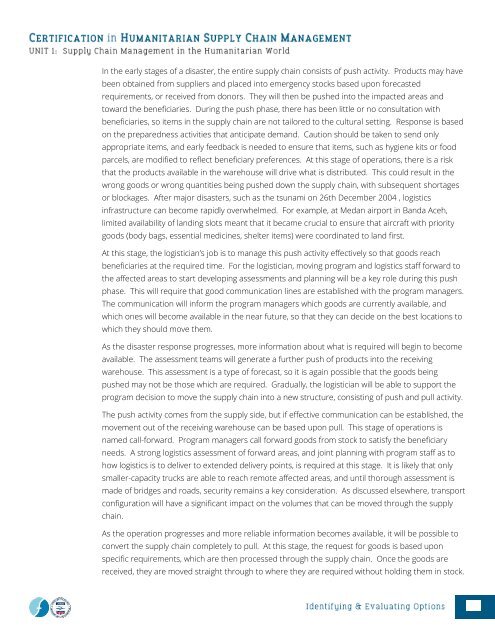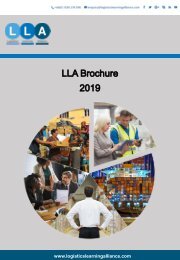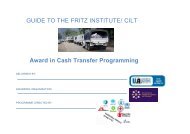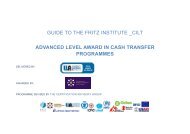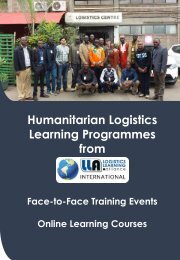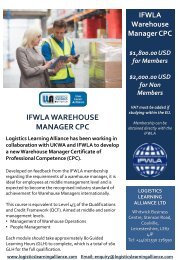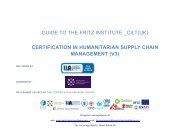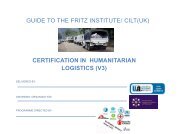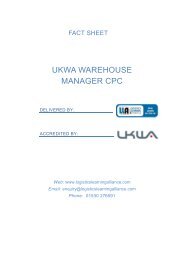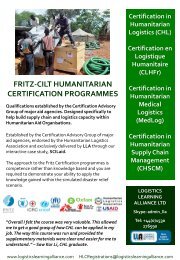CHSCM 3.0 - Unit 1 - SCM in the Humanitarian World
Learning Materials for Unit 1 of the Certification in Humanitarian Supply Chain Management (CHSCM).
Learning Materials for Unit 1 of the Certification in Humanitarian Supply Chain Management (CHSCM).
Create successful ePaper yourself
Turn your PDF publications into a flip-book with our unique Google optimized e-Paper software.
In <strong>the</strong> early stages of a disaster, <strong>the</strong> entire supply cha<strong>in</strong> consists of push activity. Products may have<br />
been obta<strong>in</strong>ed from suppliers and placed <strong>in</strong>to emergency stocks based upon forecasted<br />
requirements, or received from donors. They will <strong>the</strong>n be pushed <strong>in</strong>to <strong>the</strong> impacted areas and<br />
toward <strong>the</strong> beneficiaries. Dur<strong>in</strong>g <strong>the</strong> push phase, <strong>the</strong>re has been little or no consultation with<br />
beneficiaries, so items <strong>in</strong> <strong>the</strong> supply cha<strong>in</strong> are not tailored to <strong>the</strong> cultural sett<strong>in</strong>g. Response is based<br />
on <strong>the</strong> preparedness activities that anticipate demand. Caution should be taken to send only<br />
appropriate items, and early feedback is needed to ensure that items, such as hygiene kits or food<br />
parcels, are modified to reflect beneficiary preferences. At this stage of operations, <strong>the</strong>re is a risk<br />
that <strong>the</strong> products available <strong>in</strong> <strong>the</strong> warehouse will drive what is distributed. This could result <strong>in</strong> <strong>the</strong><br />
wrong goods or wrong quantities be<strong>in</strong>g pushed down <strong>the</strong> supply cha<strong>in</strong>, with subsequent shortages<br />
or blockages. After major disasters, such as <strong>the</strong> tsunami on 26th December 2004 , logistics<br />
<strong>in</strong>frastructure can become rapidly overwhelmed. For example, at Medan airport <strong>in</strong> Banda Aceh,<br />
limited availability of land<strong>in</strong>g slots meant that it became crucial to ensure that aircraft with priority<br />
goods (body bags, essential medic<strong>in</strong>es, shelter items) were coord<strong>in</strong>ated to land first.<br />
At this stage, <strong>the</strong> logistician’s job is to manage this push activity effectively so that goods reach<br />
beneficiaries at <strong>the</strong> required time. For <strong>the</strong> logistician, mov<strong>in</strong>g program and logistics staff forward to<br />
<strong>the</strong> affected areas to start develop<strong>in</strong>g assessments and plann<strong>in</strong>g will be a key role dur<strong>in</strong>g this push<br />
phase. This will require that good communication l<strong>in</strong>es are established with <strong>the</strong> program managers.<br />
The communication will <strong>in</strong>form <strong>the</strong> program managers which goods are currently available, and<br />
which ones will become available <strong>in</strong> <strong>the</strong> near future, so that <strong>the</strong>y can decide on <strong>the</strong> best locations to<br />
which <strong>the</strong>y should move <strong>the</strong>m.<br />
As <strong>the</strong> disaster response progresses, more <strong>in</strong>formation about what is required will beg<strong>in</strong> to become<br />
available. The assessment teams will generate a fur<strong>the</strong>r push of products <strong>in</strong>to <strong>the</strong> receiv<strong>in</strong>g<br />
warehouse. This assessment is a type of forecast, so it is aga<strong>in</strong> possible that <strong>the</strong> goods be<strong>in</strong>g<br />
pushed may not be those which are required. Gradually, <strong>the</strong> logistician will be able to support <strong>the</strong><br />
program decision to move <strong>the</strong> supply cha<strong>in</strong> <strong>in</strong>to a new structure, consist<strong>in</strong>g of push and pull activity.<br />
The push activity comes from <strong>the</strong> supply side, but if effective communication can be established, <strong>the</strong><br />
movement out of <strong>the</strong> receiv<strong>in</strong>g warehouse can be based upon pull. This stage of operations is<br />
named call-forward. Program managers call forward goods from stock to satisfy <strong>the</strong> beneficiary<br />
needs. A strong logistics assessment of forward areas, and jo<strong>in</strong>t plann<strong>in</strong>g with program staff as to<br />
how logistics is to deliver to extended delivery po<strong>in</strong>ts, is required at this stage. It is likely that only<br />
smaller-capacity trucks are able to reach remote affected areas, and until thorough assessment is<br />
made of bridges and roads, security rema<strong>in</strong>s a key consideration. As discussed elsewhere, transport<br />
configuration will have a significant impact on <strong>the</strong> volumes that can be moved through <strong>the</strong> supply<br />
cha<strong>in</strong>.<br />
As <strong>the</strong> operation progresses and more reliable <strong>in</strong>formation becomes available, it will be possible to<br />
convert <strong>the</strong> supply cha<strong>in</strong> completely to pull. At this stage, <strong>the</strong> request for goods is based upon<br />
specific requirements, which are <strong>the</strong>n processed through <strong>the</strong> supply cha<strong>in</strong>. Once <strong>the</strong> goods are<br />
received, <strong>the</strong>y are moved straight through to where <strong>the</strong>y are required without hold<strong>in</strong>g <strong>the</strong>m <strong>in</strong> stock.


